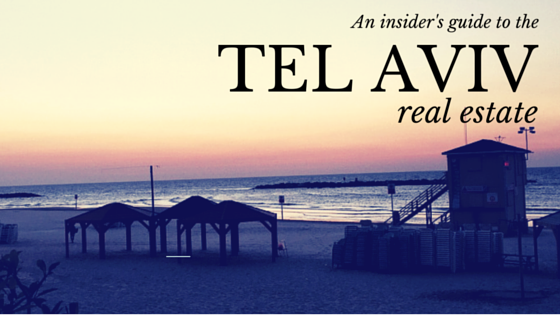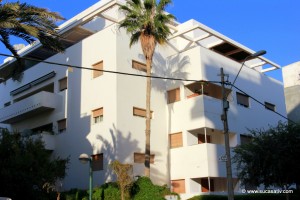An Insider’s Guide to the Tel Aviv Real Estate

I originally wrote this article back in May of 2012, and found myself amazed at the dramatic changes in prices as I went on updating the numbers. The prices back in 2012 were hitting the $7,000-mark p/m2 whereas now, they have well passed the $10,000 mark! And according to Global Property Guide, Tel Aviv has gone from being the 20th most expensive city in the world, up to the 12th.
Some quick Tel Aviv residential stats:
Prices p/m2: $10,166
Rental yield: 2.3%
Rent p/month: $2,318

Tel Aviv, earning some impressive titles over the years, it is known as the “The city that never sleeps” due to its cosmopolitan lifestyle alongside its beaches, parks, cafés, restaurants, bars and nightlife. Visited by over 1.6 million foreign tourists annually, turning it into a popular destination. In 2010, Tel Aviv was ranked 34th in Knight Frank’s world city survey; named the third “hottest city for 2011” by Lonely Planet; third best in the Middle East & Africa by Travel + Leisure Magazine; ranked best ‘Gay’ city in the world beating out New York in 2012 the ninth best beach city in the world by National Geographic and it also happens to be the 12th most expensive city in the world, as of 2015.
So, it’s no wonder people from everywhere keep flocking to live here, but the question remains – how much are people willing to pay in order to live in this great city? Apparently, quite a lot.
[Tweet “#TelAviv is ranked the 12th most expensive city in the world…”]
When buying real estate in Tel Aviv, the average price is a bit rough to measure. Its most attractive areas are concentrated in the beating heart of the city, bounded by HaYarkon Park to the north, Ibn Gvirol to the east, Neve Tzedek to the south and the shoreline to the west.
As the real estate in Israel, and mainly the Tel Aviv market is highly influenced by events going on in Europe, it is high demand along with little supply causing prices to constantly be on the rise. But not just. With thousands of empty apartments scattered in the city owned by foreigners living abroad, using them as holiday homes, it seems as if Tel Aviv has no more room to grow. New high-rise construction is taking place in the city, replacing the standard 3-4 storey buildings Tel Aviv is so known for. Easing the supply by utilizing little space left, buyers are now faced with the dilemma of having to purchase in contemporary high-rise towers, where prices seem more reasonable (better value for money), or compromise in either the location or the apartment’s features. And yet, buyers seem to prefer Tel Aviv as it is known for, searching for the “older” and more unique styles.
When in the hunt for the perfect home in the White City, you will encounter four main types of architecture, each with its own unique style and distinct location.
The mysterious ‘Eclectic’ architecture is mostly found in the ‘old city’ of Tel Aviv – Old Jaffa and North of Jaffa, Neve Tzedek and in some parts of Tel Aviv’s Lev Ha’ir; these real estate gems are in high demand due to their unique architectural style and glamorous history (built at the beginning of the 20th century). These post Ottoman-era buildings are characterized with double high ceilings, arched pillars, magnificent fairy-tale like balconies, and spacious living spaces. Most of them have gone through some heavy renovations, and yet the majority of them are not even used for residential purposes. These magnificent Eclectic style apartments and private villas are no doubt a landmark for eternity, and therefore extremely rare, but if you’ve got your eyes set on one of them, then be prepared for high end prices.
The international ‘Bauhaus’ style was introduced in the 1930s by German architects, and thus earning Tel Aviv its ‘White City’ title by UNESCO. The Tel Aviv Lev Ha’ir neighborhood has become a top real estate location over the years due its many Bauhaus buildings; these remarkable buildings are known for their white, clean-cut design, round or square balconies, high ceilings, massive live-in spaces (120 m2 and above) all located in some of Tel Aviv’s prime locations. Many of them can be found along Rothschild blvd., Melchett, Ahad Ha’am, around the Habima National Theatre, center of Dizengoff and even in Tel Aviv’s ‘Old North’.
The majority of them have been meticulously restored, and there are some still in need of such renovations, making Tel Aviv’s urban appearance more grey than white. Some of these buildings have been given slight facilitations by the municipality, granting entrepreneurs from all over the country the possibility to add two more floors, an elevator and even parking spaces for residents. The average prices for Bauhaus apartments are relatively high, where in “Modern” Bauhaus buildings duplex penthouses, where the top two floors are all new, can go up to an average of 56,000 + NIS p/m2.
Tel Aviv mainly consists of 3-4 storey buildings, and it is in the early 1950’s, that Tel Aviv has transformed from the Bauhaus architecture style, to the ‘Garden City’ era. Facade pillars, massive stair cases, 3-4 apartments per floor and the well-known “closed balconies”. These apartments are around the 75 to 100 sqm offering 2-3 bedrooms. The layout of these apartments are well noticed, it seems as if back in the day they didn’t believe much in “open spaces”, and each area within the apartment was separated – kitchen, dining, living room. Even though today “closed balconies” are easily noticeable around the city, these apartments were originally built with open balconies allowing its’ residents to enjoy the Mediterranean sun, but over the years’ residents gave up on sitting in the sun and chose to “close” their balconies in favor for additional living space.
A lot of these apartments have gone through interior renovations throughout due to more ‘younger’ and modern requests, yet some of them still remain untouched. Even though some of these buildings have been renovated and an elevator has been added, the vast majority of these buildings do not have elevators nor parking. Exploring these “old school” apartments truly is an experience and buyers are very fond by the potential to turn them over into modern style living.
Beautiful and contemporary boutique buildings as well as High-Rises are standing out and rapidly taking place in the White City. With elite, new construction noticed in Tel Aviv’s shoreline, Lev Ha’ir and Kikar Hamedina, these high-end projects offer every means of style and luxury-living known. The majority of them offer some sort of view, be it sea or city, with full amenities, high-tech modern design and all located in prime, prime locations. When looking to buy one of these luxury homes you are definitely in for a treat, as you get to enjoy the best of living in Tel Aviv.
According to ‘Global Property Guide’, Tel Aviv is ranked the 12th most expensive city in the world with buying prices approaching the $10,200-mark p/m2. Prices have been on the rise, according to this article by Global Property Guide, and if that’s not all, the real estate market tends to ‘bloom’ as summer approaches.
As for rentals in the city, they are high, with prices averaging $2,000 yet they go quick with the majority of them being snapped by young professionals and couples, as the rental market too, is influenced by Tel Aviv’s seasons. New apartments are not listed daily, but once it does – there’s a good chance it may be well gone before you ever noticed it. While searching for the right apartment in the city can be frustrating, know that it’s all about being in the right place at the right time.
If investing in real estate is your thing, then you will find investing in Tel Aviv quite an adventure. With an average 2.3% yield, purchasing an apartment and renting it out is not great in the city, to say the least. However, great deals can be found if you are in for a quick flip; buy, renovate, sell. The true money lies in medium scale investments, such as searching for buildings with additional permits.
Building on roof-tops has become very trendy over the past few years, and savvy investors seem to always be in the hunt for the right roof to build on.
When in the hunt for the perfect home, note that Tel Aviv cannot be compared to any other city in the world. Each city has its own distinguished character, style and price, and this Mediterranean Sea side gem is constantly evolving, adapting itself to its residents. Yes, real estate prices are high, it is quite an expensive city to live in, and the local purchasing power is not the best (if compared to other big cities in the world), but no matter where you decide to purchase or rent your home in Tel Aviv, Tel Aviv is a charming medley of architectural styles coexisting alongside each other, with amazing weather all year round, friendly people and with a lifestyle that gives a true fight to some of the world’s top cities. Pricey? Perhaps.
